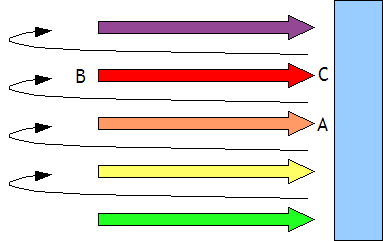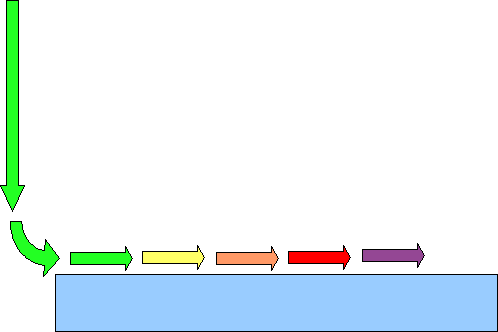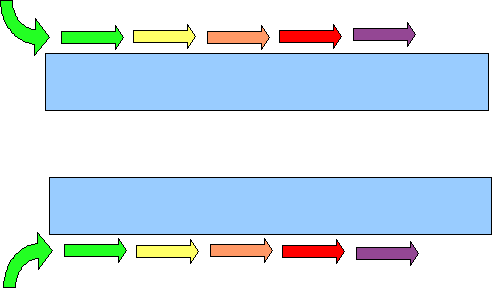
A student reached the head end of the long activation line at position A. After completing the task with Sernida, the student looked at the long line for the next station and asked whether he could simply hand his slip over to Romple at position C. Of course he could not, he had to get in a second long line back at position B.

This got me to thinking about the flow structure in the gym today. We
are mimicking the old "parallel" lines flow structure. What with the
new system, why not model it on a production line and students down a
line:

Of course then a bottleneck at any one position throttles back the
whole production line. To help ameliorate the impact of one slow
station, maybe a couple of lines could run at the same time, side by
side, a multi-threaded line:

Not sure if this would help overall, but psychologically the student would not have the perception of having to "start over" again in a second long line. Thought would have to be given also the number of workers per task along the line: if one station was significantly slower due to long task per student times, then the downstream stations would be starved of word and the upstream stations could be blocked by students piling up behind the bottleneck.
This is the first attempt at this process, and for a first attempt it is going well. There are some long waits, but this is to be expected for a new process. I thought I would share my notes while they are fresh in my mind.
I can summarize my notes by saying "more fingers on more keyboards" and I do NOT mean that people should be hired who have twelve fingers! ;-)
This Tuesday morning there were three areas that generated long lines, and best as I could tell, the underlying culprit was data entry for the freshmen and non-course selected returning students.
Activation generated a hefty line. Activation meant entering a new student record for many students. With ten fingers on one keyboard, this became a slow spot, though not the slowest. I realize and fully understand the desire to control errors on initial entry by putting a single highly trained data entry specialist in that position. I would have made the exact same decision. I am not in any way questioning what was a logical and necessary decision on a first run through of the system. I would however, work on training up a second body to work that position for future runs of registration.
Possibly the densest lines were those where students waited to have their course selections typed into the system. Specifically this was necessary only for those students who had not course selected in the spring or summer. This group of students included, or so I gather, the new freshmen (maybe not all?), and returning students who course selected with advisors on Monday.
In a perfect dream world, the advisor would have done the course selection data entry while working with the student, but practically this appears impossible. For example, at the time of freshmen course selection on Friday, most classes were still full as a result of spring course selection. Open registration did not occur until Tuesday. That is, the course selection was not "released" until Tuesday. So one can really only do this new student data entry work on Tuesday. That or a "waiting list" would have to be built on the previous Friday by the advisor's course selections, a list of "stand by passengers" for a class that would get slotted into open seats as available on Tuesday.
Shy of that perfect dream world, the obvious solution to the lines at mid-table would be more hands on more keyboards. The scope of the data entry is fairly limited, the work fairly repetitive. Maybe volunteer faculty or staff could be given temporary ids and passwords for the three days of the registration. Given a hour of training, I know I could probably help out. Other experienced faculty could also likely help - those who have been around long enough to know the programs and the course selection options.
Additional hands and keyboards might be one facet of a multi-pronged solution. The college might ask the freshmen to come in "waves." 8:30 last names A to D. 9:30 E to H. 10:30 I to M. Or take it the one step further used at the University of Illinois: randomize the alphabet so the last name "A" is not a "benefit" (first come, first into a class during open registration).
On a high note, the business office's use of number to call students with a waiting area that included chairs was absolutely brilliant. Whoever planned that area deserves an innovative idea award and I do not mean next May, they should be appreciated in some way in the here and now.
Possibly the longest line was for the production of an ID. Students who had come in at 8:30 were still bottled up at that station at 11:00, and no where near the front of the line. The students had lined up chairs to deal with the long wait. Here the college might deploy a system I once saw at an entertainment park. Student's might be issued tickets with times on them. Suppose the average time to produce a card is two minutes (it looked like it was more quite frankly), then the tickets would marked at two minute intervals:
10:00
10:02
10:04
and so forth. A student would have an "appointment" to get their ID done.
I discussed the concept of a single service number with another person in the gym today. This would take the business office idea and attempt to scale it across the gym. Theoretically, each area could give out their own numbers on different colored slips of paper, but this would surely lead to chaos as different areas called a number. One would have to have a set of "now serving" electronic number boards behind each area so a student would know when their number is being called for the area for which they are waiting. This leads to the "what if" idea "what if a student got a single number on entry to the gym?"
When a student walks in, they take a number. That number includes an ID card production time (set a reasonable length of time after 8:30 - one presumes student number one through the door at 8:30 gets ticket number one). Stations take students in numeric turn. There are some obvious problems. If number two gets stalled and number three gets ahead of number two, can a downstream station take three ahead of two? How does the downstream station take care of a list of skipped numbers that grows in size and complexity during the day. In my mind I can almost envision slats of paper strips in slots like those once used by air traffic control to determine whom had not been called. In other words, I think this would get complicated, but maybe someone can think of a way to make such a system work.